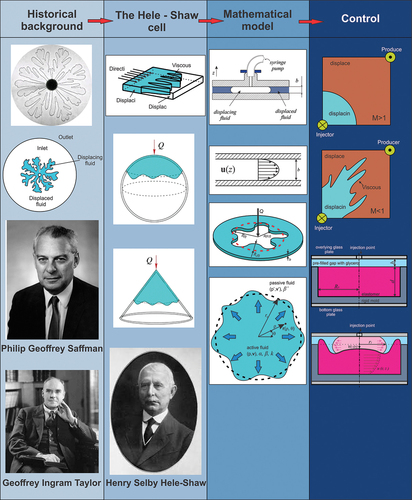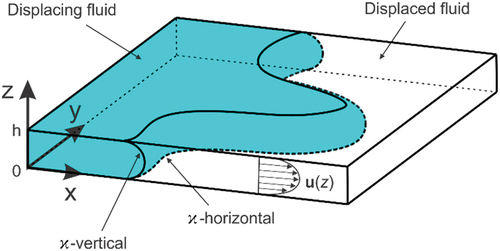Figures & data
Figure 1. (a) The Kelvin-Helmholtz instability [Citation7]; (b) from left to right, viscous, gravitational and inertial coiling respectively [Citation8]; (c) the Rayleigh–Taylor instability [Citation9]; (d) wine tears [Citation10]; (e) and (f) immiscible [Citation11] and miscible [Citation12] viscous fingering, respectively.
![Figure 1. (a) The Kelvin-Helmholtz instability [Citation7]; (b) from left to right, viscous, gravitational and inertial coiling respectively [Citation8]; (c) the Rayleigh–Taylor instability [Citation9]; (d) wine tears [Citation10]; (e) and (f) immiscible [Citation11] and miscible [Citation12] viscous fingering, respectively.](/cms/asset/0ed93754-dfc6-4463-a407-9d986aed6b30/tapx_a_2370838_f0001_oc.jpg)
Figure 2. Viscous fingering in Hele-Shaw cell with a planar channel geometry (a) and radial geometry (b).

Figure 3. Oil recovery during the secondary and tertiary phases without and with the presence of viscous fingering (a comparison of displacement front stability). Adapted from [Citation69].
![Figure 3. Oil recovery during the secondary and tertiary phases without and with the presence of viscous fingering (a comparison of displacement front stability). Adapted from [Citation69].](/cms/asset/16506418-acd3-4969-a6a8-811e8411e611/tapx_a_2370838_f0003_oc.jpg)
Figure 4. MR (Magnetic resonance) signal intensity with flow rate 0.03 ml/min, pressure 6MPa and temperature 295 K shows the displacement process in quartz glass sands BZ-02. The CO2 distribution is uneven prior to breakthrough, however, the displacement achieves a balance after some time, thus stabilizing the water and CO2 distribution [Citation78].
![Figure 4. MR (Magnetic resonance) signal intensity with flow rate 0.03 ml/min, pressure 6MPa and temperature 295 K shows the displacement process in quartz glass sands BZ-02. The CO2 distribution is uneven prior to breakthrough, however, the displacement achieves a balance after some time, thus stabilizing the water and CO2 distribution [Citation78].](/cms/asset/fa7cacbc-f7e9-48b0-bf60-c069dad1a317/tapx_a_2370838_f0004_oc.jpg)
Figure 5. Model of growing tumour and invading neighbouring tissue; Adapted from [Citation87].
![Figure 5. Model of growing tumour and invading neighbouring tissue; Adapted from [Citation87].](/cms/asset/745dbb1a-011a-4eba-af9a-8513a765000a/tapx_a_2370838_f0005_oc.jpg)
Figure 6. Cross sections of the flat convergent (a) and divergent (b) Hele-Shaw cells [Citation106]; Spherical (c) and conical (d) Hele-Shaw cell. Adapted from [Citation107].
![Figure 6. Cross sections of the flat convergent (a) and divergent (b) Hele-Shaw cells [Citation106]; Spherical (c) and conical (d) Hele-Shaw cell. Adapted from [Citation107].](/cms/asset/2a06af7e-dfbd-4178-b67d-0b63213bbf57/tapx_a_2370838_f0006_oc.jpg)
Figure 8. Expanding air bubble displacing the fluid between the plates (left) and velocity profile (right).

Figure 9. A perturbed interface in a radial flat rigid wall Hele-Shaw cell; Adapted from [Citation119].
![Figure 9. A perturbed interface in a radial flat rigid wall Hele-Shaw cell; Adapted from [Citation119].](/cms/asset/2654f5d7-25c3-4aac-a389-6ff8354dbe64/tapx_a_2370838_f0009_oc.jpg)
Figure 10. A complex bifurcation pattern of viscous fingering simulated by the DLA model; the patterns’ ages are indicated by their colours, with the first generated region being blue and the newly formed being red [Citation132].
![Figure 10. A complex bifurcation pattern of viscous fingering simulated by the DLA model; the patterns’ ages are indicated by their colours, with the first generated region being blue and the newly formed being red [Citation132].](/cms/asset/4a4a0168-fc2d-46a1-b111-f27aec70d975/tapx_a_2370838_f0010_oc.jpg)
Figure 11. Schematic diagram of an elasto-rigid Hele-Shaw cell: a narrow gap between a rigid horizontal top plate and an elastomer confined within a rigid mould (left); fluid injected into the compliant Hele-Shaw cell at a constant flow rate spreads outwards, with a radial front position , deforming the elastomer and displacing fluid resident in the cell; Adapted from [Citation168].
![Figure 11. Schematic diagram of an elasto-rigid Hele-Shaw cell: a narrow gap between a rigid horizontal top plate and an elastomer confined within a rigid mould (left); fluid injected into the compliant Hele-Shaw cell at a constant flow rate spreads outwards, with a radial front position rf, deforming the elastomer and displacing fluid resident in the cell; Adapted from [Citation168].](/cms/asset/c09bd6fa-1844-4359-989c-55274215f8a5/tapx_a_2370838_f0011_oc.jpg)
Hydrodynamically unstable displacement () can be stabilized by electrokinetic control; an electro-osmotic flow can be stabilized by a positive current (electrokinetic thinning), however, a negative current of the same magnitude makes the displacement front unstable, resulting in the finger patter of smaller wavelengths [Citation175].
![Hydrodynamically unstable displacement (M<1) can be stabilized by electrokinetic control; an electro-osmotic flow can be stabilized by a positive current (electrokinetic thinning), however, a negative current of the same magnitude makes the displacement front unstable, resulting in the finger patter of smaller wavelengths [Citation175].](/cms/asset/6fb6b831-05f3-4d91-b478-b62b907d4572/tapx_a_2370838_f0012_oc.jpg)


